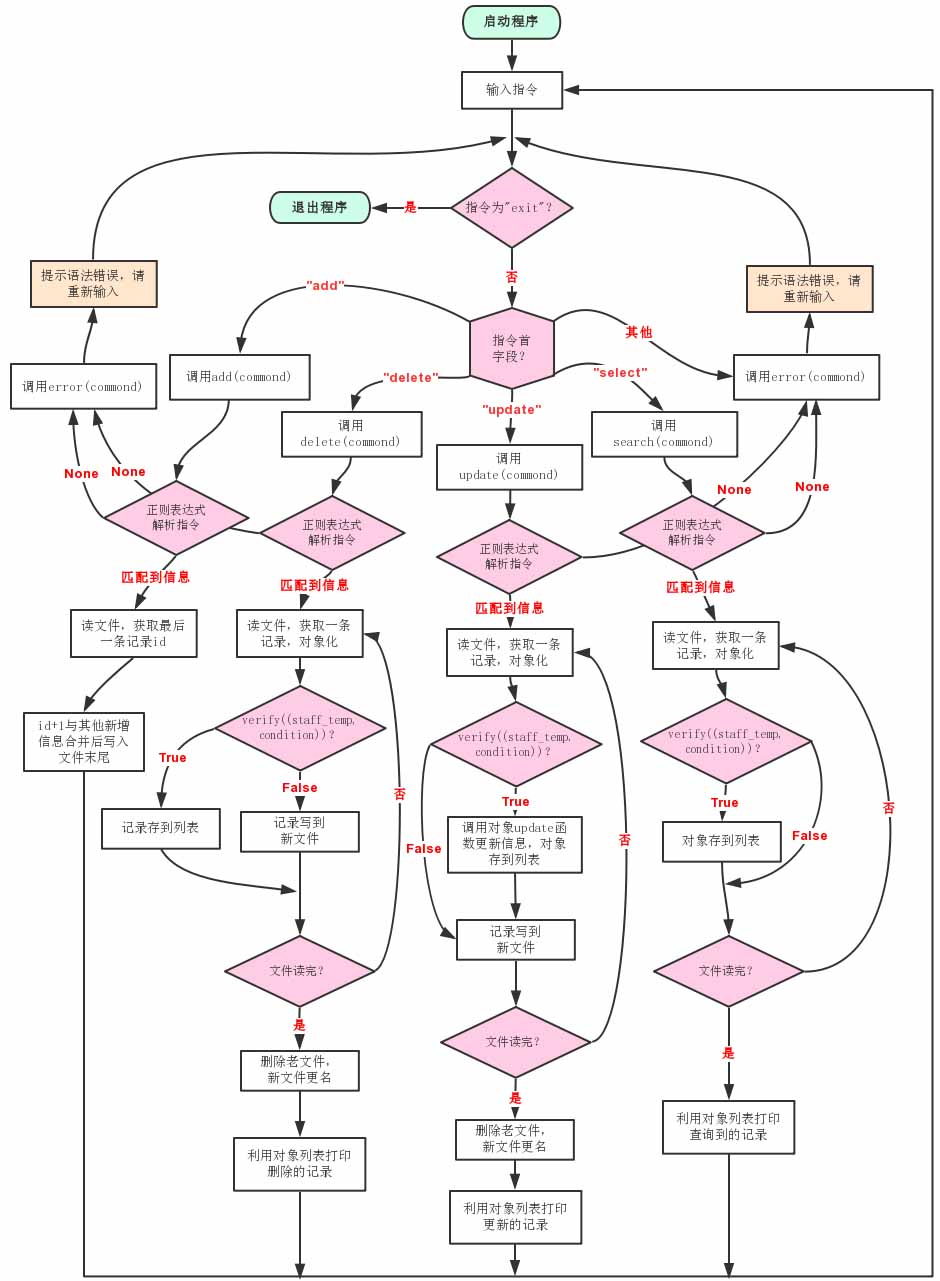1.功能简介
此程序模拟员工信息数据库操作,按照语法输入指令即能实现员工信息的增、删、改、查功能。
2.实现方法
• 架构:
本程序采用python语言编写,关键在于指令的解析和执行:其中指令解析主要运用了正则表达式来高效匹配有效信息;指令执行通过一个commd_exe主执行函数和增、删、改、查4个子执行函数来实现,操作方法主要是运用面向对象方法将员工信息对象化,从而使各项操作都能方便高效实现。程序主要函数如下:
(1)command_exe(command)
指令执行主函数,根据指令第一个字段识别何种操作,并分发给相应的处理函数执行。
(2)add(command)
增加员工记录函数,指令中需包含新增员工除id号以外的其他所有信息,程序执行后信息写入员工信息表最后一行,id号根据原最后一条记录的id号自增1。
(3)delete(command)
删除员工记录函数,可根据where后的条件检索需删除的记录,并从信息表中删除。
(4)update(command)
修改和更新员工记录函数,根据where后的条件检索需更新的记录,根据set后的等式修改和更新指定的信息。
(5)search(command)
查询员工记录函数,根据where后的条件查询到相应的记录,根据select后的关键字来显示记录的指定信息,如果为*显示记录的所有信息。
(6)verify(staff_temp,condition)
员工信息验证函数,传入一个对象化的员工记录和指令中where后的条件字符串,判断记录是否符合条件,符合在返回True,否则返回False。指令包含where字段的删、改、查操作会调用此函数。
(7)logic_cal(staff_temp,logic_exp)
单个逻辑表达式的运算函数,传入一个对象化的员工记录和从where条件字符串中被and、or、not分割的单个表达式,实现=,>,<,>=,<=,like等确定的一个逻辑表达式的运算,返回结果为True或False。
• 主要操作:
数据记录包含6个关键字:id,name,age,phone,dept,enroll_date
指令可用的逻辑运算符:<,>,=,<=,>=,like,and,or,not
数据库操作:
1.增(add to xxxx values xxxx)
示例:add to staff_table values Alex Li,22,13651054608,IT,2013-04-01
2.删(delete from xxxx where xxxx)
示例:delete from staff_table where age<=18 and enroll_date like "2017"
3.改(update xxxx set xxxx where xxxx)
示例:
update staff_table set dept="Market",age=30 where dept="IT" and phone like "189"
4.查(select xxxx from xxxx where xxxx)
示例1:
select * from staff_table where age>=25 and not phone like "136" or name like "李"
示例2:
select name,age,dept from db.txt where id<9 and enroll_date like "-05-"
示例3:select * from staff_table where * #显示所有记录
•使用文件:
staff_table
存放员工信息表,作为模拟的数据库文件,每条记录包含id,name,age,phone,dept,enroll_date六项信息,如"1,Alex Li,22,13651054608,IT,2013-04-0"。
3.流程图

4.代码
|
1
2
3
4
5
6
7
8
9
10
11
12
13
14
15
16
17
18
19
20
21
22
23
24
25
26
27
28
29
30
31
32
33
34
35
36
37
38
39
40
41
42
43
44
45
46
47
48
49
50
51
52
53
54
55
56
57
58
59
60
61
62
63
64
65
66
67
68
69
70
71
72
73
74
75
76
77
78
79
80
81
82
83
84
85
86
87
88
89
90
91
92
93
94
95
96
97
98
99
100
101
102
103
104
105
106
107
108
109
110
111
112
113
114
115
116
117
118
119
120
121
122
123
124
125
126
127
128
129
130
131
132
133
134
135
136
137
138
139
140
141
142
143
144
145
146
147
148
149
150
151
152
153
154
155
156
157
158
159
160
161
162
163
164
165
166
167
168
169
170
171
172
173
174
175
176
177
178
179
180
181
182
183
184
185
186
187
188
189
190
191
192
193
194
195
196
197
198
199
200
201
202
203
204
205
206
207
208
209
210
211
212
213
214
215
|
#!usr/bin/env python3#_*_coding:utf-8_*_'staff infomation management module'__author__='Byron Li''''----------------------------------------------员工信息数据库操作指令语法---------------------------------------------数据记录包含6个关键字:id,name,age,phone,dept,enroll_date指令可用的逻辑运算符:<,>,=,<=,>=,like,and,or,not1.增(add to xxxx values xxxx) 示例:add to staff_table values Alex Li,22,13651054608,IT,2013-04-01 2.删(delete from xxxx where xxxx) 示例:delete from staff_table where age<=18 and enroll_date like "2017"3.改(update xxxx set xxxx where xxxx) 示例:update staff_table set dept="Market",age=30 where dept="IT" and phone like "189"4.查(select xxxx from xxxx where xxxx) 示例1:select * from staff_table where age>=25 and not phone like "136" or name like "李" 示例2:select name,age,dept from db.txt where id<9 and enroll_date like "-05-" 示例3:select * from staff_table where * #显示所有记录---------------------------------------------------------------------------------------------------------------------'''import reimport osclass staff(object): #员工类 def __init__(self,*args): #员工信息初始化:从字符串列表传参赋值 self.id=args[0] self.name=args[1] self.age=args[2] self.phone=args[3] self.dept=args[4] self.enroll_date=args[5] self.allinfo=','.join(args) def update(self,**kwargs): #员工信息更新:从字典传参赋值 if 'id' in kwargs: self.id=kwargs['id'] if 'name' in kwargs: self.name=kwargs['name'] if 'age' in kwargs: self.age = kwargs['age'] if 'phone' in kwargs: self.phone=kwargs['phone'] if 'dept' in kwargs: self.dept=kwargs['dept'] if 'enroll_date' in kwargs: self.enroll_date = kwargs['enroll_date'] self.allinfo = ','.join(map(str,[self.id, self.name, self.age, self.phone, self.dept, self.enroll_date])) def print_info(self,info): #员工信息打印显示:传入的参数为"*"或数据记录的若干个关键字 if info=='*': print(self.allinfo) else: info=info.split(',') res=[] for i in info: if hasattr(self,i.strip()): res.append(str(getattr(self,i.strip()))) print(','.join(res))def command_exe(command): #指令执行主函数,根据指令第一个字段识别何种操作,并分发给相应的处理函数执行 command=command.strip() return { 'add':add, 'delete':delete, 'update':update, 'select':search, }.get(command.split()[0],error)(command)def error(command): #错误提示函数,指令不合语法调用该函数报错 print('\033[31;1m语法错误,请重新输入!\033[0m\n')def add(command): #增加员工记录函数 command_parse=re.search(r'add\s*?to\s(.*?)values\s(.*)',command) #正则表达式指令解析 if(command_parse): data_file=command_parse.group(1).strip() #数据库文件 info=command_parse.group(2).strip() #需新增的员工信息,不含id id=1 #新增员工id,默认为1以防数据库为空表时新增记录id取1 with open(data_file, 'r+', encoding='utf-8') as fr: line=fr.readline() while(line): if line.strip()=='': fr.seek(fr.tell()-len(line)-2) #定位文件最后一行(只有空字符)的开头 break staff_temp = staff(*line.strip().split(',')) #读取的信息转换为staff对象 id = int(staff_temp.id) + 1 #末行员工id加1为新员工id line = fr.readline() info_new=''.join([str(id),',',info]) #id与其他信息合并成完整记录 fr.write(info_new) fr.write('\n') fr.flush() print("数据库本次\033[31;1m新增1条\033[0m员工信息:", info_new) #新增记录打印 else: error(command)def delete(command): #删除员工记录函数 command_parse=re.search(r'delete\s*?from\s(.*?)where\s(.*)',command) #指令解析 if(command_parse): data_file=command_parse.group(1).strip() #数据库文件 condition=command_parse.group(2).strip() #检索条件 data_file_bak = ''.join([data_file, '.bak']) count = 0 #删除记录计数 staff_list = [] #删除记录的员工对象列表 with open(data_file, 'r', encoding='utf-8') as fr, \ open(data_file_bak, 'w', encoding='utf-8') as fw: for line in fr: staff_temp = staff(*line.strip().split(',')) if (verify(staff_temp, condition)): #验证员工信息是否符合条件 count+=1 staff_list.append(staff_temp) continue fw.write(staff_temp.allinfo) fw.write('\n') fw.flush() os.remove(data_file) os.rename(data_file_bak, data_file) print("数据库本次共\033[31;1m删除%d条\033[0m员工信息,如下:"%count) for staff_temp in staff_list: staff_temp.print_info('*') #删除记录打印 else: error(command)def update(command): #修改和更新员工记录函数 command_parse=re.search(r'update\s(.*?)set\s(.*?)where\s(.*)',command) #指令解析 if(command_parse): data_file=command_parse.group(1).strip() #数据库文件 info=command_parse.group(2).strip() #需更新的信息 condition=command_parse.group(3).strip() #检索条件 data_file_bak=''.join([data_file,'.bak']) info = ''.join(['{', info.replace('=', ':'), '}']) #将需更新的信息按字典格式修饰字符串 info = eval(re.sub(r'(\w+)\s*:', r'"\1":', info)) #将字符串进一步修饰最终转化成字典 count = 0 staff_list = [] with open(data_file,'r',encoding='utf-8') as fr,\ open(data_file_bak,'w',encoding='utf-8') as fw: for line in fr: staff_temp=staff(*line.strip().split(',')) if(verify(staff_temp,condition)): #验证员工信息是否符合条件 staff_temp.update(**info) #调用员工对象成员函数更新信息 count += 1 staff_list.append(staff_temp) fw.write(staff_temp.allinfo) fw.write('\n') fw.flush() os.remove(data_file) os.rename(data_file_bak,data_file) print("数据库本次共\033[31;1m更新%d条\033[0m员工信息,如下:"%count) for staff_temp in staff_list: staff_temp.print_info('*') #更新记录打印 else: error(command)def search(command): #查询员工记录函数 command_parse=re.search(r'select\s(.*?)from\s(.*?)where\s(.*)',command) #指令解析 if(command_parse): info=command_parse.group(1).strip() #检索结束后需显示的信息,"*"为显示整体记录 data_file=command_parse.group(2).strip() #数据库文件 condition=command_parse.group(3).strip() #检索条件 count = 0 staff_list = [] with open(data_file,'r',encoding='utf-8') as fr: for line in fr: staff_temp=staff(*line.strip().split(',')) if(verify(staff_temp,condition)): #验证员工信息是否符合条件 count += 1 staff_list.append(staff_temp) print("数据库本次共\033[31;1m查询到%d条\033[0m员工信息,如下:" % count) for staff_temp in staff_list: staff_temp.print_info(info) #查询记录打印 else: error(command)def verify(staff_temp,condition): #员工信息验证函数,传入一个员工对象和条件字符串 if condition.strip()=='*':return True #如果条件为'*',即所有记录都满足条件 condition_list=condition.split() #检索条件字符串转列表 if len(condition_list)==0:return False logic_str=['and','or','not'] #逻辑运算字符串 且、或、非 logic_exp=[] #单个条件的逻辑表达式组成的列表,形如[‘age',' ','>','=',20] 或 [‘dept',' ','like',' ','HR'] logic_list=[] #每个条件的表达式的计算结果再重组后的列表,形如 [‘True','and','False','or','not','False'] for i in condition_list: if i in logic_str: if(len(logic_exp)!=0): logic_list.append(str(logic_cal(staff_temp,logic_exp))) #逻辑表达式计算并将返回的True或False转化成字符串添加到列表 logic_list.append(i) logic_exp=[] else: logic_exp.append(i) logic_list.append(str(logic_cal(staff_temp, logic_exp))) return eval(' '.join(logic_list)) #列表转化成数学表达式完成所有条件的综合逻辑运算,结果为True或Falsedef logic_cal(staff_temp,logic_exp): #单个逻辑表达式的运算函数 logic_exp = re.search('(.+?)([=<>]{1,2}|like)(.+)',''.join(logic_exp)) #表达式列表优化成三个元素,形如[‘age','>=',20] 或 [‘dept','like','HR'] if(logic_exp): logic_exp=list(logic_exp.group(1,2,3)) if(hasattr(staff_temp,logic_exp[0])): logic_exp[0] = getattr(staff_temp,logic_exp[0]) else: return False if logic_exp[1]=='=': #指令中的'='转化成程序中相等判别的"==" logic_exp[1]='==' if logic_exp[1]=='like': #运算符为like的表达式运算 return re.search(logic_exp[2].strip("'").strip('"'),logic_exp[0]) and True elif(logic_exp[0].isdigit() and logic_exp[2].isdigit()): #两头为数字的运算,直接eval函数转数学表达式 return eval(''.join(logic_exp)) elif(logic_exp[1]=='=='): #非数字的运算,即字符串运算,此时逻辑符只可能是‘=',若用eval函数则字符串会转成无定义变量而无法计算,所以拿出来单独用"=="直接计算 return logic_exp[0]==logic_exp[2].strip("'").strip('"') #字符串相等判别,同时消除指令中字符串引号的影响,即输引号会比记录中的字符串多一层引号 else: #其他不合语法的条件格式输出直接返回False return False else: return Falseif __name__=='__main__': #主函数,数据库指令输入和执行 while(True): command=input("请按语法输入数据库操作指令:") #指令输入 if command=='exit': print("数据库操作结束,成功退出!".center(50, '*')) break command_exe(command) #指令执行 |
以上这篇Python 模拟员工信息数据库操作的实例就是小编分享给大家的全部内容了,希望能给大家一个参考,也希望大家多多支持服务器之家。
原文链接:http://www.cnblogs.com/byron-li/archive/2017/10/22/7711623.html










